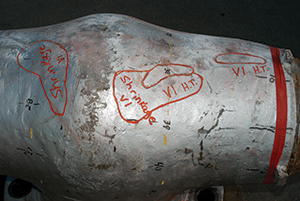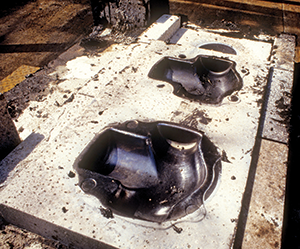Cast vs. Forged: The Ongoing Debate Takes a New Direction
In the valve industry, the cast versus forged debate has been around for many years.
#materials #standards
APPLICATION CHALLENGES
While multiple thermal cycles and higher temperatures allow operators to increase plant efficiency, they also put an immense amount of stress on system components. Degradation of material caused by creep and corrosion fatigue are detected more often in modern CCPPs and heat recovery steam generators, leading to higher maintenance levels and plant downtime.#
As a result, many valve manufacturers have started to rethink material specifications and production techniques, in particular when dealing with components for critical and severe service applications.
Valve material behavior and choices are affected by changes in the operating parameters of these modern power plants. In particular, the move from static to dynamic loads through combined cycle operations plays a role. So do increases in plant cycling impact temperature and pressure differentials, which affect the load placed on valves and pipeline components within the steam circuit.
Fluctuations in temperature create stress and elongation as valves expand and contract under different loads up to a designed yield strength. Once stresses placed on the valve exceed this yield strength, valve deformation occurs, and over time, the dimensions of components are affected. Mechanical stress eventually can cause component fatigue and failure.
KEY MATERIAL CONSIDERATIONS
In general, all valve materials, whether forged or cast, have to fulfill the demands for tensile strength and corrosion resistance found in critical process environments. The stronger the material of the valve, the better that valve can resist failure when put under pressure. This strength means higher ductility and ultimately longer product life. However, in the power generation industry, the potential for valve failure from increased plant cycling exists. The impact of high-cycling duty on steam temperature and pressure places greater stresses on valve components. This means materials must endure fluctuations and differentials throughout the lifetime of the valve.
Cast materials tend to require less mass than forged products. More mass can lead to larger thermal gradients, which can result in more stress. Because of this, casting and its relationship to voids needs to be taken into account, with consideration given to determing safety factors and allowable stress levels.
Another important aspect to consider is the metal’s ability to withstand the effects of corrosion. Corrosion is still a major problem in the power industry, often resulting in costly repairs and excessive downtime. The degradation of valve material that occurs from the combined actions of oxygen, metals and salt is exacerbated by high operating temperatures. The higher the temperature, the softer the material will become, increasing the risk of thermal fatigue.
Design codes and standards from the American Society of Mechanical Engineers (ASME) allow both forged and cast materials to be used within the primary circuit, depending on the boiler design and operational parameters. The chemical composition of these components, in particular the level of chrome, and the manufacturing method are key factors in determining creep strength and metallurgical stability. For example, WC9 grade alloys, which contain 2.25% of chrome, can retain their strength in temperatures of up to 1020°F (550°C), while higher grades, such as C12-A with 9% chrome, can withstand temperatures of up to 1130°F (610°C).
Changes in power plant operations mean the situation for forging grades is evolving. While lower grades, such as F22, containing 2.25% of chrome, can be suitable for up to 1100°F (590°C), F91 materials with 9% chrome can withstand temperatures of up to 1200°F (650°C). This is significant because increased efficiency targets of modern power plants mean operating temperatures are pushed above 1112°F (600°C). As a result, plant engineers and valve manufacturers are moving to F92 grade alloys, for which no cast equivalent within the ASME standard exists.
The differences in performance for alloys over F91 grade is also clear. For example, an F92 Class 2500 valve at 1112°F (600°C) delivers a special class rating of 223.4 bar compared with 203.1 bar for F91. At 1067°F (575°C), the ratings are the same for both materials (F91 and F92). However, at 1157°F (625°C), the difference is 190.6 bar for F92 compared with 152.1 for F91.
Although chemical composition is an important consideration because it impacts the mechanical properties of the material, the heat treatment of the material is also an essential parameter. Heat treatment determines the overall strength of the valve when operated in high temperature environments and under intense mechanical stress. Whether forging or casting, each valve needs to be heated to a normalized temperature—usually about 1832°F (1000°C) and cooled down in less than 4000 seconds to achieve a highly durable end product.
While smaller valves can be cooled down relatively quickly, valves with higher mass (and typically a larger diameter) have a much more complex cooling process. This will affect the mechanical properties of the valve—in particular its performance at high temperatures, which could lead to a reduced product lifecycle.
STRINGENT QUALITY STANDARDS
While most international standards provide guidance on the expected guaranteed life of a material in ambient temperatures, no official data is available for tests in high temperatures. Still, the power industry’s changing operating environment, particularly the stresses of higher cycling and regular shutdowns, call for changes in testing. As a result, tests that take into consideration additional parameters, such as operating hours, number of shutdowns and temperature range, are increasingly important to accurately evaluate the lifespan of products.
With changes to material guidelines and regulations imminent, many engineers already are specifying materials beyond the current requirements so they can secure future compliance. In fact, some governing bodies, such as the American Society of Testing and Materials (ASTM) and ASME, have started to include detailed manufacturing process requirements into their specifications. Besides fulfilling stringent criteria in terms of the chemical composition, testing procedures and physical properties of the material, many valves now also have to be either cast or forged, depending on the industry and application.
Ultrasupercritical coal-fired plants, for example, can operate above 1112°F (600°C), making these applications ideally suited to F92 forged grade materials. In the coming years, the combined cycle market will move towards these temperature ranges and the use of F92 will become more prevalent in these applications.
VALVE CASTING SUITABILITY
Casting still represents a large share of the valve manufacturing industry. In fact, most steel components start as castings, a process in which molten metal is poured into a customized mold and then solidified. The advantages to this procedure include:
- Flexibility in design. Valves can be cast-to-shape, which gives greater variety and complexity of shape (from processing in liquid form).
- Greater metal choice (custom alloys) because foundries have full control over the chemical metal composition to meet unique requirements at an affordable cost. This can ensure valves are modified to meet exact specifications (i.e., the level of ferrite can be controlled to enhance corrosion resistance, etc.).
- Reduced machining costs because cast requires less machining than forging when more complex shapes are needed.
- Wider availability, which means replacements are easier.
- Different shapes. Cast valves can have a contoured shape (rounded edges).
Although castings remain an integral part of the valve manufacturing industry, the shift towards higher pressure operation in the last few years has exposed shortcomings that include:
- The solidification process can produce small impurities, such as voids and cracks. This can mean lower mechanical properties and costly and time-intensive weld repair.
- Welding and post-weld heat treatment alters the microstructure of castings, resulting in higher creep and much lower hardness. This requires rigorous inspection of a valve to ensure it has maintained the proper strength and creep resistance.
- Higher specifications in 9-chrome material can only be achieved after extensive heat-treatment, resulting in longer delivery times. This can be caused by many factors including non-destructive evaluation and other testing requirements.
Still, significant improvements in mold- and core-making processes have reduced defects on casted valves. For example, an increasing number of foundries have adopted low-pressure die-casting techniques to improve the overall mechanical integrity of the final product.
RISE OF FORGED VALVES
- Less material waste because less reworking is necessary. (The valve is forged into shape out of one solid piece/ingot).
- Because of the immense pressures involved in the manufacturing process, the forging process reduces surface porosity and closes up internal cavities and voids. This allows forged valves to retain structural integrity, resulting in a mechanically stronger and more durable product (with higher ductility and tensile strength).
- The flexibility of being able to manufacture the forged material to the intermediate rating means less wall thickness for enhanced performance from thermal cycle fatigue with 9Cr-1Mo material. Less wall thickness has a smaller temperature gradient, which requires less time for material thickness to reach equilibrium. Therefore, there is less potential for thermal fatigue, which offers a robust solution for power plants that cycle through start-up and phase-down on a daily basis.
- Forged material can be machined to meet specific design conditions using intermediate ratings. This gives end users and asset owners another alternative. With the use of an intermediate rating, a lighter weight valve more suitable to cycle duties can be produced. The lighter weight valve can reduce the heating/cooling stresses as the units cycle on and off, particularly because thinner wall components can heat and cool more quickly, resulting in fewer thermal stresses.
While forging produces a very strong piece of equipment, some consequences and limitations to be aware of include:
- Forging is cost and energy-intensive. It requires extensive work to refine the product and achieve the required shape and finish.
- Limitations exist on size, shape and thickness because processing occurs in a solid state.
- Larger forgings need to be produced from two or more pieces and welded together.
IT DEPENDS ON APPLICATION
The ultimate choice will come down to evaluating the operational needs of a specific plant to identify the best valve solution. While forged valves offer enhanced performance for high-temperature and severe service applications, the cost and difficulty of repeatability for standardized products may restrict some use. The key consideration for plant engineers assessing cast components is identifying the long-term effect of an acceptable void within the valve’s construction once it is installed.
One way to mitigate risk is to work with an experienced manufacturer that offers engineering expertise in both cast and forged valves and can advise on the most appropriate ASME-compliant product to meet specific plant and application needs.
Arvo Eilau is marketing manager,‒Power, Pentair Valves & Controls (www.pentair.com). Reach him at http://valves.pentair.com/valves.
RELATED CONTENT
-
The Materials That Make Up Valves
EDITOR’S NOTE: Materials used in the manufacture of valves and how they perform in different applications is a topic of huge interest to everyone who works with valves.
-
Control Valves for Hydrogen Applications
Proper sizing, material selection and monitoring are as important as ever.
-
WCC and LCC Casting in ASME B16.34
Q: Why do WCC and LCC castings have different maximum allowable temperatures in ASME B16.34?










 Unloading large gate valve.jpg;maxWidth=214)


